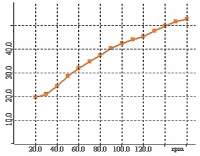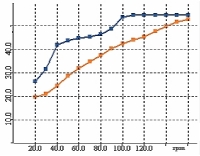|
A powder is fluidized when a gas is injected into the powder causing the powder particles to separate and enter a fluid like state. The properties of the powder, as well as the pressure and temperature of the gas, determines the degree of fluidization. For fine powders, the gas pressure required to fluidize the particles is very low. This low pressure can be created by rotating the powder in a drum. Varying the rate of drum rotation results in changes of the fluidization pressure. The fluidization of a fine powder can be studied by measuring the volumetric expansion of the powder in a rotating drum as a function of the rotation rate of the drum. |
Fluidization |
In addition, the rate at which a fluidized fine powder settles to its original state can be measured by stopping the rotation and reducing the fluidization pressure to zero.
The REVOLUTION Fluidization Test measures a powder's volume increase at specified angular velocity intervals in a rotating drum to create a fluidization function for the powder. During the fluidization test, the rate of decrease in the powder's volume is measured to create a settling function for the material. Appropriate powders for the REVOLUTION Fluidization test include: toners, catalysts, powder coatings, and other powders with low pressure fluidization potential.
There are four optional process steps to the Fluidization Analysis: Prep, Settling, Analysis, and Settling. These four steps are discussed below.
|
Prep Step Within the Prep Step, the user can rotate the powder at a chosen rotation rate and length of time to completely fluidize the material. This step will allow the user establish a repeatable initial fluidized state for this analysis. This prep step can be skipped if the user wishes to study the fluidization of the material in its original state. |
Fluidized Sample |
|
Settling Step If the material has been fluidized in the prep step, the material must return to its un-fluidized state to perform the fluidization analysis. In this step, the rotation of the drum is stopped for a specific length of time or until the volume of the sample reaches its original state. The rate at which the powder's volume decreases is measured and is used to create a settling function. |
Settling |
|
Fluidization Analysis Step During the analysis, the user sets the start and end drum rotation rate with the desired step rate. REVOLUTION will begin the drum rotation at the specified start rotation rate, stepping up the rate at the desired intervals until the end rotation rate is achieved. The user can chose to ramp up the angular speed at any desired intervals to achieve the equilibrium fluidized state. |
Fluidization Analysis |
After a specified equilibration time has elapsed at the end rotation rate, REVOLUTION will begin computing the statistical measurements described below for this fluidization analysis step. In Figure A, the statistical analysis shows the operator the rate at which the powder fluidized by the increase in the overall volume. In Figure B, the fluidization test results are shown for two different powder samples: one sample fluidizes at a faster rate than the other.
|
Figure A - Fluidization Function Sample height vs rotation speed |
Figure B - Overlay of Fluidization Function for 2 samples |
Settling Step
After the fluidized analysis, the REVOLUTION measures the settling time of the powder. This settling time is valuable for anyone who is fluidizing a coating for example and needs to know the amount of time required for the powder to settle on the coating surface. In Figure C, the analysis shows the operator the rate at which the powder settled after the fluidization operation had been stopped.
|
Sample Settling |
Figure C - Overlay of settling rate for two samples |



